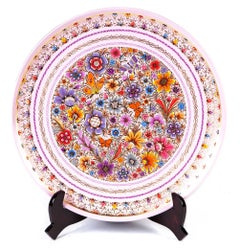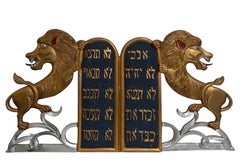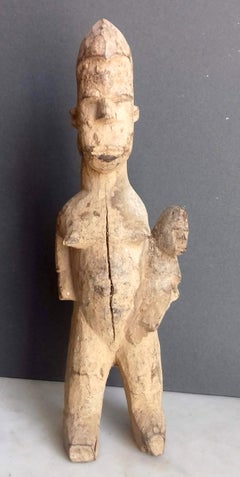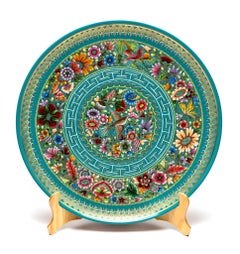Agustín Jorge Martínez Ramírez More Art
to
1
Overall Width
to
1
1
1
2
324
229
117
116
Artist: Agustín Jorge Martínez Ramírez
Platon Rosa con Flores / Wood carving Lacquer Mexican Folk Art
By Agustín Jorge Martínez Ramírez
Located in Jesus del Monte, MX
FREE SHIPPING TO WORLDWIDE!
Artisan: Agustin Jorge Martinez Ramirez
Fine wood pink plate, gold-platted with resin material. Decorated with flora and f...
Category
2010s Folk Art Agustín Jorge Martínez Ramírez More Art
Materials
Wood, Lacquer
Related Items
Rare Folk Art Hebrew Judaica Carved Gilded Wood Lions Torah Synagogue Sculpture
Located in Surfside, FL
Paint and gold paint on wood
Circa early to mid 20th century.
This is not signed
A treasure from a proud congregation. It is a hand-carved wooden sculpture showing the Tablets of the Law flanked by two Lions of Judah. Their paws held the tablets. Their roaring mouths faced outward, protecting the commandments from threats. In a foliage design with gold and silver paint.
Circa 1920-1940's. This Neoclassical, Judaic, Art Deco, Egyptian revival, Shul, Aron Kodesh hand carving, wood with gilding, Hebrew lettering ten commandments sign sculpture, was produced probably in New York.
There was a show at the Folk Art Museum titled “Gilded Lions and Jeweled Horses: The Synagogue to the Carousel” That featured these antique magnificent pieces. From gilded lions to high-stepping horses, the sacred to the secular, and the Old World to the New, “Gilded Lions and Jeweled Horses: The Synagogue to the Carousel” traces the journey of Jewish woodcarvers and other artisans from Eastern and Central Europe to America and the unsung role they played in establishing a distinct Jewish culture in communities throughout the United States. The exuberant artworks stand as a testament to a history of survival and transformation and provide a surprising revelation of the link that was forged between the synagogue and the carousel as immigrant Jewish artists transferred symbolic visual elements into this vernacular American idiom. The first major study of this important aspect of the Jewish contribution to American folk art, the exhibition features approximately one hundred artworks and objects, including rare documentary photographs of Eastern European synagogue arks and carved gravestones, sacred carvings, papercuts, and carousel animals. Some of these same Jewish European carvers worked on Coney Island amusement park rides and carousel horses and other carnival and circus carvings.
Category
Early 20th Century Folk Art Agustín Jorge Martínez Ramírez More Art
Materials
Metal
$3,600
H 20.25 in W 38 in D 1 in
African art tribal maternity figure, Lobi peoples Ghana - Ivory Coast
Located in Norwich, GB
A delightful African maternity figure from the Lobi peoples of the Ivory Coast/Ghana. With a serene yet feisty expression, the mother is carry...
Category
Mid-20th Century Folk Art Agustín Jorge Martínez Ramírez More Art
Materials
Wood
$372
H 7.88 in W 2.76 in D 2.37 in
Original 1949 Painted Ceramic Tile Flowers Hand Painting Grandma Moses Folk Art
By Grandma Moses
Located in Surfside, FL
Dogwood Blossoms. 1949.
Dimensions: Tile 6 X 6 Frame 7.75 X 7.75 inches.
Provenance: The tile was in the possession of the Beers family and is from the estate.
Catalogue raisonné number at Galerie St Etienne: Kallir T #87
An exceedingly rare, authenticated, and hand painted floral decorated tile by Grandma Moses herself, fired by Helen Beers. Tile dated 1949 and signed moses recto as well as 'Moses Fired by Helen C. Beers, painted by Grandma Moses, Pinewold Pottery'. There are only a handful of these known to exist, approximately five, this being one of those five, outside the private collection of Galerie St. Etienne, Manhattan NY.
This listing is for the tile only. The photo archive, from the family, will be listed separately and is included here just for provenance and reference.
Anna Mary Robertson Moses (1860 – 1961), or Grandma Moses, was an American folk artist. She began painting in earnest at the age of 78 and is a prominent example of a newly successful art career at an advanced age. Moses gained popularity during the 1950s, having been featured on a cover of Time Magazine in 1953. She was a subject of numerous television programs and of a 1950 Oscar-nominated biographical documentary. Her autobiography, titled My Life's History, was published in 1952. She was also awarded two honorary doctoral degrees. She embroidered pictures with yarn, until disabled by arthritis. In her 1961 obituary, The New York Times said: "The simple realism, nostalgic atmosphere and luminous color with which Grandma Moses portrayed simple farm life and rural countryside won her a wide following. She was able to capture the excitement of winter's first snow, Thanksgiving preparations and the new, young green of oncoming spring ... In person, Grandma Moses charmed wherever she went. A tiny, lively woman with mischievous gray eyes and a quick wit, she could be sharp-tongued with a sycophant and stern with an errant grandchild."
Moses's work has been a subject of numerous museum exhibitions worldwide and has been extensively merchandised, such as on greeting cards. In 2006, her 1943 painting titled Sugaring Off was sold at Christie's New York for US$1.36 million, setting an auction record for the artist. Her work is fundamental for any Naive art or Americana collection.
She was known as either "Mother Moses" or "Grandma Moses", and although she first exhibited as "Mrs. Moses", the press dubbed her "Grandma Moses", and the nickname stuck. As a young wife and mother, Moses was creative in her home; for example, in 1918 she used house paint to decorate a fireboard. Beginning in 1932, Moses used yarn to embroider pictures for friends and family. She created quilt objects, a form of "hobby art". Lucy R. Lippard stated in "The Word in Their Hands" that she found "hobby art" to be "an activity so 'low' on the art lists that it still ranks way below 'folk art'". She found that hobby art often involves reuse of otherwise discarded objects.
Moses painted scenes of rural life from earlier days, which she called "old-timey" New England landscapes. Moses said that she would "get an inspiration and start painting; then I'll forget everything, everything except how things used to be and how to paint it so people will know how we used to live." From her works of art, she omitted features of modern life, such as tractors and telephone poles.
Her early style is less individual and more realistic or primitive, with a lack of knowledge of, or perhaps rejection of, basic perspective. Initially she created simple compositions or copied existing images. As her career advanced, she created complicated, panoramic compositions of rural life.
During a visit to Hoosick Falls in 1938, Louis J. Caldor, an art collector who worked as an engineer in the state of New York, saw paintings made by Moses in the window of a drug store. He bought their supply and ten more from her Eagle Bridge house for $3 or $5 each. The next year, three Grandma Moses paintings...
Category
1940s Folk Art Agustín Jorge Martínez Ramírez More Art
Materials
Ceramic, Paint
$4,500
H 7.75 in W 7.75 in
Wedding Chest of Corinne de Blaru, French 19th Century Folk Art Painted
Located in Cotignac, FR
Vintage French folk art, Early 19th century, painted wood wedding, hope or bridal chest, for the wedding of Charles Herbert Frederic and Corinne de Blaru in 1848. The names and dates...
Category
Early 19th Century Folk Art Agustín Jorge Martínez Ramírez More Art
Materials
Iron
$2,126
H 11.03 in W 17.72 in D 11.82 in
"Windows", Contemporary Quilt
By Bethan Ash
Located in Brecon, Powys
This abstract art quilt has been created by using a collage technique Inspired by the patterns left on a windowpane after a shower of rain. Using salt resist on wet paint has created...
Category
2010s Folk Art Agustín Jorge Martínez Ramírez More Art
Materials
Fabric
European 19th Century Folk Art Painted Wooden Hope, Bridal Wedding Chest
Located in Cotignac, FR
Early 19th century European folk art painted wood wedding, hope or bridal chest.
A superb example of a European hope or wedding chest in remarkable condition Of characteristic dome ...
Category
Early 19th Century Folk Art Agustín Jorge Martínez Ramírez More Art
Materials
Iron
$2,115
H 11.03 in W 17.72 in D 11.82 in
Guatemala. Maschera di Baila de la Conquista. Inizio XX secolo
Located in Firenze, IT
Questa maschera guatemalteca del inizio del XX secolo, scolpita in legno e utilizzata per la danza della Riconquista (Baila de la Conquista) , raffigura vividamente un uomo europeo, ...
Category
Early 20th Century Folk Art Agustín Jorge Martínez Ramírez More Art
Materials
Wood, Intaglio
$235 Sale Price
20% Off
H 7.49 in W 5.71 in D 4.34 in
Vintage wood face mask, dark brown
Located in San Diego, CA
Vintage wood mask. The edge undulates and is lightweight. Date and artist unknown.
Category
20th Century Folk Art Agustín Jorge Martínez Ramírez More Art
Materials
Wood
"Wood Carving, " Wood Painted in Yellow, Red, Blue, & Green made in Indonesia
Located in Milwaukee, WI
This wood carving was created by an unknown Indonesian artist. It is approximately 17" tall by 7" wide. It was painted with abstract designs in primary colors.
Category
20th Century Folk Art Agustín Jorge Martínez Ramírez More Art
Materials
Wood
The Race 2, Contemporary Quilt
By Bethan Ash
Located in Brecon, Powys
Collage inspired by Welsh folk tales and the story of Taliesin by Robert Nye. Each panel is full of abstract imagery texture and doodles conveying a dream like language where so many...
Category
2010s Folk Art Agustín Jorge Martínez Ramírez More Art
Materials
Fabric
Tree Of Life, Contemporary Quilt
By Bethan Ash
Located in Brecon, Powys
The inspiration for ’Tree Of Life’ came from a quilt I made for the ‘Quilt Art’ group exhibition ‘Moving On‘. The quilt was called ‘Black Hole’ (Mourning quilt) and describes the fee...
Category
2010s Folk Art Agustín Jorge Martínez Ramírez More Art
Materials
Fabric
"Spring Meadow, " Oil on Wood signed by Robert Richter
By Robert Richter
Located in Milwaukee, WI
"Spring Meadow" is an original oil painting by Robert Richter. The artist signed, stamped his initials, and titled the piece on the back of the painting. This painting depicts an exp...
Category
2010s Outsider Art Agustín Jorge Martínez Ramírez More Art
Materials
Wood, Oil
Previously Available Items
Plato Azul-Verde Perfilado en Oro / Wood carving Lacquer Mexican Folk Art
By Agustín Jorge Martínez Ramírez
Located in Jesus del Monte, MX
FREE SHIPPING TO WORLDWIDE!
Artisan: Agustin Jorge Martinez Ramirez
IAM 1st. Place Category “Gold Bathed Laca”
INSTITUTO DEL ARTESANO MICHOACANO XLVII...
Category
2010s Folk Art Agustín Jorge Martínez Ramírez More Art
Materials
Wood, Lacquer
Agustín Jorge Martínez Ramírez more art for sale on 1stDibs.
Find a wide variety of authentic Agustín Jorge Martínez Ramírez more art available for sale on 1stDibs. You can also browse by medium to find art by Agustín Jorge Martínez Ramírez in lacquer, wood and more. Not every interior allows for large Agustín Jorge Martínez Ramírez more art, so small editions measuring 14 inches across are available. Customers who are interested in this artist might also find the work of Tom Carapic, Kira Yustak, and Jessica JH Roller. Agustín Jorge Martínez Ramírez more art prices can differ depending upon medium, time period and other attributes. On 1stDibs, the price for these items starts at $900 and tops out at $1,000, while the average work can sell for $950.



